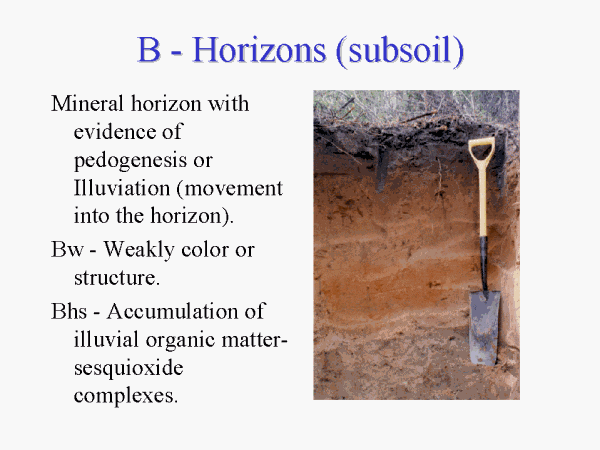| First Previous Next Last Index Home Text Slide 7 of 14 |
 |
Notes:
B horizons: are commonly referred to as the subsoil. They are a zone of accumulation where rain water percolating through the soil has leached material from above and it has precipitated within the B horizons or the material may have weathered in place. Well drained soils typically have the brightest color development within the B horizons.
Field criteria:
From Soil Taxonomy:
B horizons: Horizons which have formed below an A,
E, or O horizon; they are dominated by the
obliteration of all or much of the original rock structure and
show one or more of the following:
(1) Illuvial concentration of silicate clay, iron, aluminum, humus, carbonates, gypsum, or silica, alone or in combination;(2) Evidence of removal of carbonates;
(3) Residual concentration of sesquioxides;(4) Coatings of sesquioxides that make the horizon conspicuously lower in color value, higher in chroma, or redder in hue, without apparent illuviation of iron, than overlying and underlying horizons;
(5) Alteration which forms silicate clay or liberates oxides, or both, and which forms a granular, blocky, or prismatic structure if volume changes accompany changes in moisture content; or(6) Brittleness.
All the different kinds of B horizons are, or were originally, subsurface horizons. Included as B horizons, where contiguous to other genetic horizons, are layers of illuvial concentration of carbonates, gypsum, or silica which are the result of pedogenic processes (and may or may not be cemented), and brittle layers that show other evidence of alteration, such as prismatic structure or illuvial accumulation of clay.
Examples of layers that are not B horizons are: layers in which clay films either coat rock fragments or cover finely stratified unconsolidated sediments, regardless of whether the films were formed in place or by illuviation; layers into which carbonates have been illuviated but which are not contiguous to an overlying genetic horizon; and layers with gleying but no other pedogenic changes.